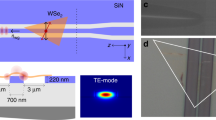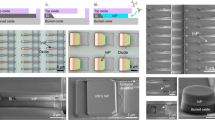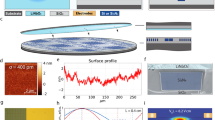Abstract
The most-awaited convergence of microelectronics and photonics promises to bring about a revolution for on-chip data communications and processing1. Among all the optoelectronic devices to be developed, power-efficient nanolaser diodes able to be integrated densely with silicon photonics and electronics are essential to convert electrical data into the optical domain. Here, we report a demonstration of ultracompact laser diodes based on one-dimensional (1D) photonic crystal (PhC) nanocavities2,3,4 made in InP nanoribs heterogeneously integrated on a silicon-waveguide circuitry. The specific nanorib design enables an efficient electrical injection of carriers in the nanocavity without spoiling its optical properties. Room-temperature continuous-wave (CW) single-mode operation is obtained with a low current threshold of 100 µA. Laser emission at 1.56 µm in the silicon waveguides is obtained with wall-plug efficiencies greater than 10%. This result opens up exciting avenues for constructing optical networks at the submillimetre scale for on-chip interconnects and signal processing.
This is a preview of subscription content, access via your institution
Access options
Access Nature and 54 other Nature Portfolio journals
Get Nature+, our best-value online-access subscription
$29.99 / 30 days
cancel any time
Subscribe to this journal
Receive 12 print issues and online access
$209.00 per year
only $17.42 per issue
Buy this article
- Purchase on Springer Link
- Instant access to full article PDF
Prices may be subject to local taxes which are calculated during checkout




Similar content being viewed by others
References
Miller, D. Device requirements for optical interconnects to silicon chips. Proc. IEEE 97, 1166–1185 (2009).
Foresi, J. S. et al. Photonic-bandgap microcavities in optical waveguides. Nature 390, 143–145 (1997).
Halioua, Y. et al. III–V photonic crystal wire cavity laser on silicon wafer. J. Opt. Soc. Am. B 27, 2146–2150 (2010).
Deotare, P. B., McCutcheon, M. W., Frank, I. W., Khan, M. & Lončar, M. High quality factor photonic crystal nanobeam cavities. Appl. Phys. Lett. 94, 121106 (2009).
Roelkens, G. et al. Adhesive bonding of InP∕InGaAsP dies to processed silicon-on-insulator wafers using DVS-bis-benzocyclobutene. J. Electrochem. Soc. 153, G1015 (2006).
Fedeli, J. M. et al. Photonic–electronic integration with bonding. IEEE J. Sel. Top. Quantum Electron. 20, 350–358 (2014).
Liang, D. et al. Low-temperature, strong SiO2–SiO2 covalent wafer bonding for III–V compound semiconductors-to-silicon photonic integrated circuits. J. Electron. Mater. 37, 1552–1559 (2008).
Fang, A. W. et al. Electrically pumped hybrid AlGaInAs–silicon evanescent laser. Opt. Express 14, 9203–9210 (2006).
Van Campenhout, J. et al. A compact SOI-integrated multiwavelength laser source based on cascaded InP microdisks. IEEE Photon. Technol. Lett. 20, 1345–1347 (2008).
Mutsuo, S. et al. Directly modulated buried heterostructure DFB laser on SiO2/Si substrate fabricated by regrowth of InP using bonded active layer. Opt. Express 22, 12139–12147 (2014).
Park, H. et al. A hybrid AlGaInAs–silicon evanescent amplifier. IEEE Photon. Technol. Lett. 19, 230–232 (2007).
Chen, H.-W., Kuo, Y. & Bowers, J. E. High speed hybrid silicon evanescent Mach–Zehnder modulator and switch. Opt. Express 16, 20571–20576 (2008).
Liu, L. et al. Carrier-injection-based electro-optic modulator on silicon-on-insulator with a heterogeneously integrated III–V microdisk cavity. Opt. Lett. 33, 2518–2520 (2008).
Spuesens, T. et al. Compact integration of optical sources and detectors on SOI for optical interconnects fabricated in a 200 mm CMOS pilot line. J. Light. Technol. 30, 1764–1770 (2012).
Liu, L. et al. An ultra-small, low-power, all-optical flip-flop memory on a silicon chip. Nat. Photon. 4, 182–187 (2010).
Yablonovitch, E. Inhibited spontaneous emission in solid-state physics and electronics. Phys. Rev. Lett. 58, 2059–2062 (1987).
Painter et al. Two-dimensional photonic band-gap defect mode laser. Science 284, 1819–1821 (1999).
Strauf, S. et al. Self-tuned quantum dot gain in photonic crystal lasers. Phys. Rev. Lett. 96, 127404 (2006).
Raineri, F. et al. Dynamics of band-edge photonic crystal lasers. Opt. Express 17, 3165–3172 (2009).
Altug, H., Englund, D. & Vučković, J. Ultrafast photonic crystal nanocavity laser. Nat. Phys. 2, 484–488 (2006).
Akahane, Y., Asano, T., Song, B.-S. & Noda, S. High-Q photonic nanocavity in a two-dimensional photonic crystal. Nature 425, 944–947 (2003).
Park, H.-G. et al. Electrically driven single-cell photonic crystal laser. Science 305, 1444–1447 (2004).
Jeong, K.-Y. et al. Electrically driven nanobeam laser. Nat. Commun. 4, 839–846 (2013).
Ellis, B. et al. Ultralow-threshold electrically pumped quantum-dot photonic-crystal nanocavity laser. Nat. Photon. 5, 297–300 (2011).
Takeda, K. et al. Few-fJ/bit data transmissions using directly modulated lambda-scale embedded active region photonic-crystal lasers. Nat. Photon. 7, 569–575 (2013).
Bazin, A., Raj, R. & Raineri, F. Design of silica encapsulated high-Q photonic crystal nanobeam cavity. J. Light. Technol. 32, 952–958 (2014).
Casey, H. C. & Carter, P. L. Variation of intervalence band absorption with hole concentration in p-type InP. Appl. Phys. Lett. 44, 82–83 (1984).
Bazin, A. et al. Thermal management in hybrid InP/silicon photonic crystal nanobeam laser. Opt. Express 22, 10570–10578 (2014).
Crosnier, G. et al. High Q factor InP photonic crystal nanobeam cavities on silicon wire waveguides. Opt. Lett. 41, 579–582 (2016).
Crosnier, G. et al. Subduing surface recombination for continuous-wave operation of photonic crystal nanolasers integrated on silicon waveguides. Opt. Express 23, 27953–27959 (2015).
Karle, T. J. et al. Heterogeneous integration and precise alignment of InP-based photonic crystal lasers to complementary metal–oxide semiconductor fabricated silicon-on-insulator wire waveguides. J. Appl. Phys. 107, 063103 (2010).
Taillaert, D. et al. Grating couplers for coupling between optical fibers and nanophotonic waveguides. Jpn. J. Appl. Phys. 45, 6071–6077 (2006).
Acknowledgements
This work was supported by the FP7 European integrated project PhoxTrot (FP7-ICT 318240).
Author information
Authors and Affiliations
Contributions
G.C. and F.R. proposed the concept and designed the hybrid lasers. G.B. and I.S. grew the InP-based heterostructures. G.C., D.S., F.R. and S.B. fabricated the hybrid lasers. G.C., P.M. and D.S. performed the electro-optical characterization. D.S., R.R. and F.R. wrote the article. R.R. and F.R. led the project.
Corresponding author
Ethics declarations
Competing interests
The authors declare no competing financial interests.
Supplementary information
Supplementary information
Supplementary information (PDF 914 kb)
Rights and permissions
About this article
Cite this article
Crosnier, G., Sanchez, D., Bouchoule, S. et al. Hybrid indium phosphide-on-silicon nanolaser diode. Nature Photon 11, 297–300 (2017). https://doi.org/10.1038/nphoton.2017.56
Received:
Accepted:
Published:
Issue Date:
DOI: https://doi.org/10.1038/nphoton.2017.56
This article is cited by
-
Electrically-pumped compact topological bulk lasers driven by band-inverted bound states in the continuum
Light: Science & Applications (2023)
-
Ultra-low threshold lasing through phase front engineering via a metallic circular aperture
Nature Communications (2022)
-
Ultralow-threshold laser using super-bound states in the continuum
Nature Communications (2021)
-
Photonic crystal optical parametric oscillator
Nature Photonics (2021)
-
Ultra-coherent Fano laser based on a bound state in the continuum
Nature Photonics (2021)



